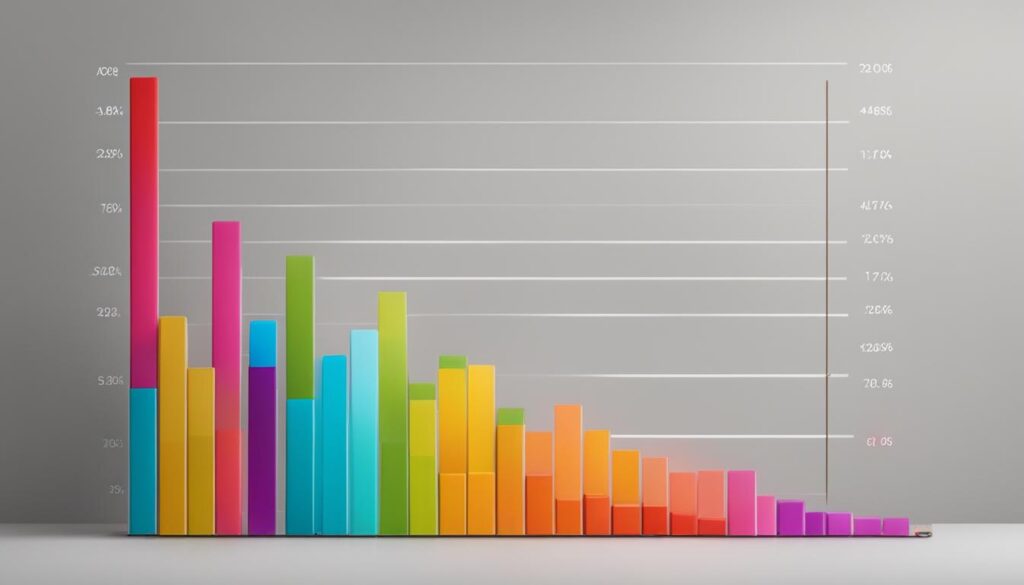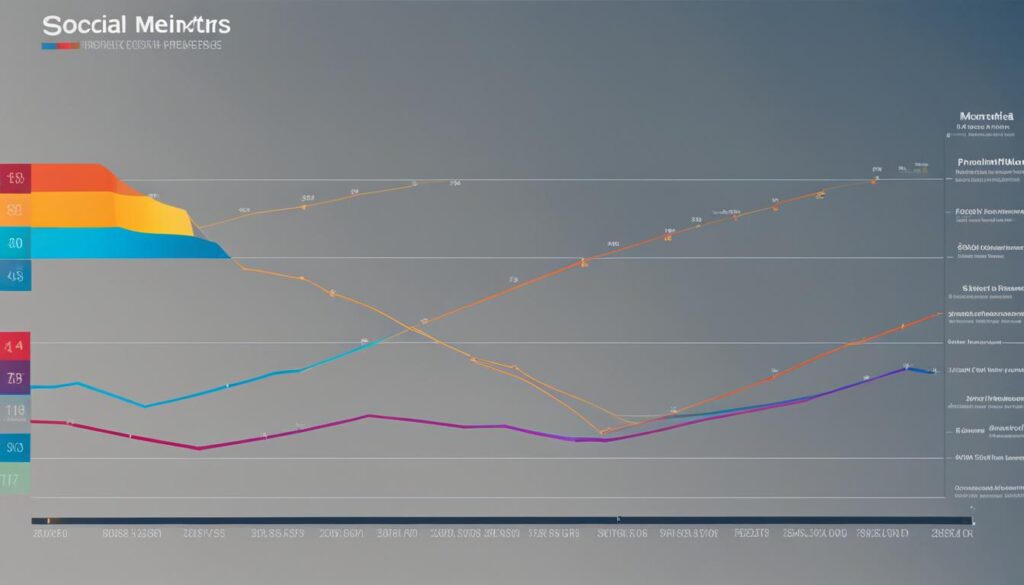Are you looking to gain insights into your spending habits and optimize your budget? Look no further than the Social Spend Analyzer. This powerful tool allows you to track your social spending and compare it to your peers, giving you a comprehensive overview of your financial behavior.
With the Social Spend Analyzer, you can easily monitor your social media expenses and analyze them in relation to others in your industry or social circle. By comparing your spending habits, you can identify areas where you may be overspending and make informed decisions to optimize your budget.
Tracking your social spending is crucial in today’s digital age, where social media platforms play a significant role in our lives. It’s essential to keep your spending in check and ensure you’re making the most of your budget.
Key Takeaways:
- Use the Social Spend Analyzer to track and compare your social spending.
- Identify areas where you may be overspending and optimize your budget.
- Gaining insights into your spending habits can help you make informed financial decisions.
- Monitor your social media expenses in relation to your industry or social circle.
- Maximize the effectiveness of your budget by analyzing your social spending.
The Importance of Follower Growth and Audience Size
Follower growth and audience size are crucial social media metrics that provide valuable insights into the health of your social channels and the awareness you’re building. By tracking these metrics, you can better understand the effectiveness of your content strategy and optimize your budget for maximum impact.
Follower growth measures the net new followers gained over a specific time period, indicating the success of your content types and campaigns. It serves as a key metric for demonstrating the return on investment (ROI) of your social media efforts. Additionally, tracking the follower growth rate, which measures the percentage increase in followers over a certain time period, allows you to gauge how quickly your audience is expanding.
Audience size, while sometimes considered a vanity metric, is still important for assessing overall channel performance and influencing higher-level metrics. It provides a baseline for measuring engagement, conversions, and other key performance indicators. By monitoring both follower growth and audience size, you can develop a comprehensive understanding of your social media reach and optimize your content strategy accordingly.
Understanding the importance of follower growth and audience size is essential for leveraging social media metrics effectively. By incorporating these metrics into your analytics toolkit, you can gain valuable insights into your social media performance and make data-driven decisions to improve your content strategy and maximize your impact on your target audience.
The Importance of Follower Growth and Audience Size
| Metric | Description |
|---|---|
| Follower Growth | Net new followers gained over a specific time period. |
| Follower Growth Rate | Percentage increase in followers over a certain time period. |
| Audience Size | Total number of individuals following your social channels. |
Measuring Customer Satisfaction and Feedback through Social Media
Social media platforms offer a unique opportunity for businesses to collect customer feedback and measure customer satisfaction. By actively engaging with customers on these channels, brands can gain valuable insights into their products, services, and overall customer experience. Two key metrics that can be tracked to gauge customer satisfaction on social media are reply time and total response volume.
Reply time measures how quickly a brand responds to customer messages on social media. It reflects the level of customer care and can significantly impact overall customer satisfaction. By minimizing response times, brands can show their commitment to addressing customer concerns promptly.
Total response volume, on the other hand, indicates the number of responses a brand sends to customers on social media. Tracking this metric helps identify missed messages and improve customer care. A higher total response volume demonstrates an active and engaged customer service team.
“Reply time and total response volume are crucial metrics for measuring customer satisfaction on social media. Brands that prioritize timely, helpful responses can significantly enhance their reputation and build stronger relationships with their customers.”
Additionally, brands can use direct messaging or surveys on platforms like Twitter and Facebook to gather feedback on customer satisfaction. These methods provide a convenient and efficient way for customers to share their thoughts and opinions. Analyzing these responses can help brands identify areas for improvement and make necessary adjustments to enhance customer satisfaction.
| Metric | Definition | Importance |
|---|---|---|
| Reply Time | The time it takes for a brand to respond to customer messages on social media | Reflects customer care and responsiveness |
| Total Response Volume | The number of responses a brand sends to customers on social media | Indicates an engaged and active customer service team |
By utilizing social media as a platform for measuring customer satisfaction and feedback, brands can better understand their customers’ needs and expectations. This understanding allows for targeted improvements and the delivery of exceptional customer experiences, ultimately leading to improved brand health and customer loyalty.

Understanding Awareness Metrics in Social Media
Social media platforms offer a wealth of data that can help businesses gauge the effectiveness of their social media strategies and understand the level of awareness they are generating. By analyzing key awareness metrics, businesses can gain valuable insights into the reach and impact of their content, allowing them to optimize their social media strategies for maximum visibility and engagement.
One important awareness metric to track is impressions. Impressions measure how many times a post is displayed to someone, providing an indication of its potential visibility and popularity. By monitoring impressions, businesses can assess the effectiveness of their content in capturing the attention of their target audience and identify opportunities for improvement.
Another crucial metric is reach. Reach refers to the unique viewers a post has, representing the number of individuals who have seen it. By tracking reach, businesses can gauge the extent of their content’s distribution and assess the size of their potential audience. This information can be used to refine targeting strategies and reach a larger segment of their target audience.
| Awareness Metrics | Description |
|---|---|
| Impressions | The number of times a post is displayed |
| Reach | The unique viewers of a post |
| Video Views | The number of times a video is viewed |
Video views are also a crucial awareness metric, particularly on platforms like TikTok. Video views count as impressions and indicate both awareness and engagement. By monitoring video views, businesses can assess the popularity and impact of their video content, identifying opportunities to create more engaging and shareable videos.
Understanding awareness metrics is essential for businesses looking to optimize their social media strategies. By analyzing impressions, reach, and video views, businesses can gain valuable insights into the effectiveness of their content and make data-driven decisions to improve their social media campaigns.

Tracking Customer Retention and Loyalty through Social Media Engagement
Customer retention and loyalty are crucial aspects of maintaining a healthy brand and driving long-term success. With the rise of social media, businesses now have a powerful tool at their disposal to track and improve customer retention and loyalty through social media engagement. By monitoring key metrics and analyzing customer behavior on social platforms, businesses can gain valuable insights and make data-driven decisions to enhance their customer experience.
Social media engagement is a key indicator of customer loyalty and satisfaction. Tracking metrics such as likes, comments, shares, and mentions can provide valuable feedback on customer sentiments and preferences. By actively engaging with customers on social media, businesses can foster a sense of community and strengthen relationships, ultimately resulting in higher customer retention rates.

Furthermore, social media allows businesses to gather real-time feedback and address customer concerns promptly. By monitoring conversations and comments, businesses can identify areas for improvement and take proactive measures to address customer issues. This level of responsiveness not only enhances customer satisfaction but also demonstrates a dedication to exceptional customer service.
Effective social media engagement strategies can also contribute to brand health and overall customer perception. When customers feel heard and valued, they are more likely to develop a strong affinity for the brand and become loyal advocates. These loyal customers can positively impact brand reputation and attract new customers through word-of-mouth referrals.
By utilizing social media analytics tools and tracking customer engagement metrics, businesses can continuously refine their strategies and optimize their social media campaigns. This data-driven approach enables businesses to make informed decisions that align with customer needs, ultimately leading to improved customer retention, increased loyalty, and a stronger brand presence in the digital landscape.
Table: Key Metrics for Tracking Customer Retention and Loyalty through Social Media Engagement
| Metric | Description |
|---|---|
| Follower Growth | Measure of new followers gained over time, indicating brand awareness and audience growth. |
| Engagement Rate | Percentage of followers who actively engage with social media content through likes, comments, shares, etc. |
| Customer Sentiment | Analyze customer feedback and sentiment expressed in comments and direct messages. |
| Response Time | Measure of how quickly the business responds to customer inquiries or concerns on social media. |
| Customer Retention Rate | Percentage of customers who continue to engage with the brand over a specified period. |
Tracking and analyzing these key metrics can provide valuable insights into customer retention and loyalty. By leveraging social media engagement effectively, businesses can build stronger relationships with customers, foster brand loyalty, and drive sustainable growth.
The Value of Social Media Benchmarking
Social media benchmarking is a crucial practice for businesses looking to gain a competitive edge and optimize their social media campaigns. By comparing your social media metrics to industry best practices and competitors, you can gather valuable insights that can inform your strategy and enhance your performance. Social media benchmarking provides a comprehensive analysis of your performance, allowing you to identify areas for improvement and make data-driven decisions.
One of the key benefits of social media benchmarking is the ability to understand how well you are performing in comparison to others. By tracking metrics such as follower growth, engagement rates, and reach, you can gain a clear picture of your performance and identify areas where you may be falling behind or excelling. This information can help you set realistic goals and benchmarks, allowing you to continuously improve and stay ahead of the competition.
Another advantage of social media benchmarking is the opportunity to gather insights from competitors and industry trends. By monitoring competitor performance, you can identify successful tactics and strategies that you can implement in your own campaigns. Additionally, staying informed about industry trends allows you to spot emerging opportunities and adapt your strategy accordingly. Social media benchmarking provides a wealth of valuable information that can inform your decision-making and help you optimize your social media efforts.
Table: Social Media Metrics Comparison
| Metric | Your Brand | Competitor A | Competitor B |
|---|---|---|---|
| Follower Growth | 5% | 7% | 4% |
| Engagement Rate | 10% | 8% | 12% |
| Reach | 100,000 | 150,000 | 80,000 |
In the example table above, we can see a comparison of key social media metrics between your brand and two competitors. This data allows you to assess your performance and identify areas for improvement. For example, your competitor, Competitor B, has a higher engagement rate, indicating that they may have a more effective content strategy. By benchmarking your metrics against competitors, you can gain valuable insights and make informed decisions to optimize your social media campaigns.
In conclusion, social media benchmarking is a valuable practice that can provide insights to improve your social media campaigns. By comparing your metrics to industry best practices and competitors, you can identify areas for improvement, gather competitive intelligence, and make data-driven decisions. Utilize social media benchmarking tools and analysis to stay ahead of the competition and continuously optimize your social media efforts for maximum impact.
Using Social Analytics to Improve Your Campaigns
Social media analytics play a crucial role in optimizing your campaigns and driving better results. By harnessing the power of data and insights, you can understand customer behavior, preferences, and potential to purchase. This enables you to tailor your marketing efforts to attract and retain the right customers, ultimately boosting your campaign’s effectiveness.
One key aspect of social media analytics is audience analysis. By delving into the demographics, interests, and behaviors of your audience, you can create highly targeted content that resonates with them. This not only increases engagement but also enhances your chances of conversion. Furthermore, social analytics allow you to identify industry influencers and understand their impact on your target audience, enabling you to collaborate with them for greater campaign success.
Another crucial metric to track is post reach and results. By analyzing the reach and engagement of your posts, you can gain insights into the content that resonates most with your audience. This helps you optimize your content strategy, ensuring that you’re consistently delivering valuable and engaging posts. Additionally, tracking brand mentions allows you to monitor conversations about your brand, identify sentiment trends, and address any customer issues promptly.
Customer Insights through Social Analytics
Social media analytics provide valuable customer insights that can shape your campaign strategy. By understanding customer sentiment, preferences, and pain points, you can fine-tune your messaging and offerings to better meet their needs. Analyzing customer behavior on social media also helps determine the best time to post, maximizing your content’s visibility and reach. Furthermore, analyzing competitor conversations gives you a competitive edge by identifying their strengths, weaknesses, and areas for improvement that you can apply to your own campaigns.
In summary, leveraging social media analytics allows you to make data-driven decisions and optimize your campaigns. By analyzing audience demographics, engagement levels, post reach, and customer insights, you can tailor your content, timing, and targeting to maximize effectiveness. Furthermore, monitoring competitor conversations and trends provides valuable insights that help you stay ahead in the digital landscape. With social analytics as your guide, you can drive better results and achieve your campaign objectives.

| Metric | Description |
|---|---|
| Audience Analysis | Examining audience demographics, interests, and behaviors to create targeted content. |
| Post Reach and Results | Analyzing the reach and engagement of posts to optimize content strategy. |
| Brand Mentions | Monitoring conversations about your brand, identifying sentiment trends, and addressing customer issues. |
| Customer Insights | Understanding customer sentiment, preferences, and behavior to shape campaign strategy. |
| Competitor Conversations | Gaining a competitive edge by analyzing competitor strengths, weaknesses, and trends. |
Conclusion
Social spending tracking through social media metrics and analytics is crucial for effectively measuring the success of your campaigns, understanding customer behavior, and optimizing your budget. By tracking key metrics such as follower growth, customer satisfaction, awareness, engagement, and conversions, you can gauge the effectiveness of your social media strategy and make data-driven decisions to improve your campaigns.
Social media benchmarking provides valuable insights into industry best practices and competitor performance, allowing you to stay ahead of the competition and continuously enhance your social media efforts. By leveraging social analytics, you can unlock the power of social spending tracking and optimize your budget for maximum impact.
With social media analytics, you gain a deep understanding of customer preferences, behavior, and potential to purchase. By analyzing audience size, engagement levels, customer demographics, and industry influencers, you can tailor your marketing efforts to attract and retain the right customers. Furthermore, social analytics enable you to track competitor conversations, avoid making the same mistakes, and gain a competitive edge in your industry.
By combining these measures and choosing the right social media metrics, such as audience analysis, post reach and results, platform engagement, best time to post, and brand mentions, you can optimize your campaigns and drive better results. Ultimately, with social media tracking and optimized budget allocation, you can enhance your social media strategy and achieve the desired impact on your brand’s success.
FAQ
What are social media metrics?
Social media metrics are data points used to measure the performance and effectiveness of social media channels, content, and overall strategies.
Why are social media metrics important?
Social media metrics are essential for tracking brand health, competitive standing, and performance benchmarks. They help inform decision-making and optimize social media strategies.
What are some key social media metrics to track?
Some key social media metrics to track include follower growth, customer satisfaction, awareness metrics, customer retention, social media referral traffic, brand health metrics, conversion rates, social media engagement metrics, click-through rates, and paid metrics.
What is the importance of follower growth and audience size?
Follower growth and audience size provide insights into the health of social channels and the awareness being built. They help demonstrate the ROI of content types and campaigns and contribute to higher-level metrics.
How can social media be used to measure customer satisfaction and feedback?
Social media provides a valuable platform for collecting customer feedback and measuring satisfaction. Metrics such as reply time, total response volume, and customer satisfaction scores help track and improve customer care.
What are awareness metrics and why are they important?
Awareness metrics, such as impressions, reach, and video views, help measure the impact of social media strategies on brand awareness. They indicate potential visibility, popularity, and engagement with content.
How do social media metrics help measure customer retention and loyalty?
Metrics like Net Promoter Score (NPS), monitoring comments, and sentiment analysis on social media help measure brand health, customer satisfaction, and identify areas for improvement to retain and build loyal customers.
What is social media benchmarking and why is it valuable?
Social media benchmarking involves comparing metrics to industry best practices and competitors. It helps understand performance, identify areas for improvement, and gather insights to enhance strategies.
How can social analytics improve social media campaigns?
Social analytics provide insights into customer behavior, preferences, and potential to purchase. By analyzing metrics like audience analysis, post reach, platform engagement, best time to post, and brand mentions, campaigns can be optimized for better results.
How Does Inflation Affect Social Spending?
Tracking inflation’s impact on finances is crucial in understanding how it affects social spending. As prices rise, the purchasing power of individuals decreases. This translates to higher costs for essential goods and services, making it challenging for governments to adequately fund social programs. Ultimately, inflation can strain budgets, leading to reduced spending on healthcare, education, and welfare, impacting the overall well-being of society.
Can Tracking Utility Spending Help Me Compare My Social Spending Habits with Others?
Yes, monthly utility spend tracking can help you compare your social spending habits with others. By keeping track of your utility expenses, you can see where your money is going and how it compares to others. This can help you make more informed decisions about your social spending.